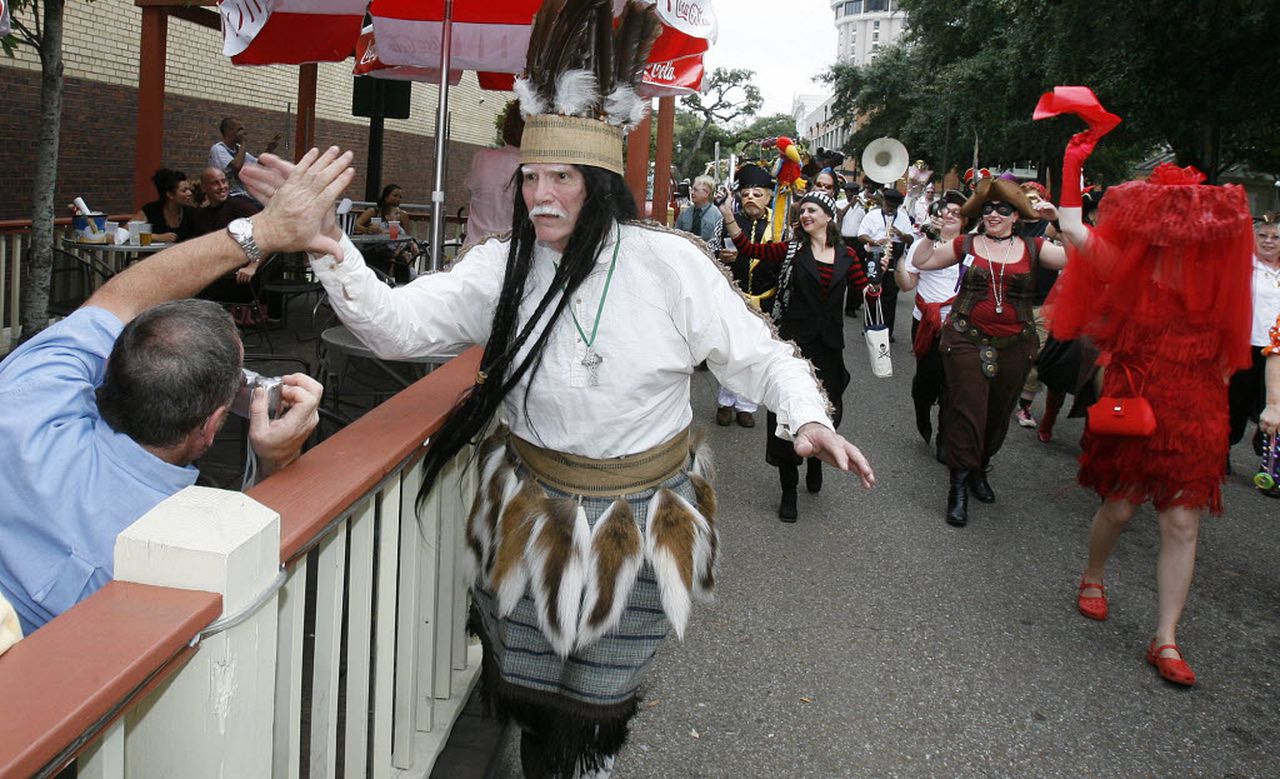Of Men and Myths: A conversation with Chief Slac
Wayne Dean has been donning the feathers and the leather-clad outfit for 38 years as Slacabamarinico, the facial Indian chief and Mobile Mardi Gras icon first invented by Joe Cain after the Civil War.
But at age 80, questions abound about Dean’s future as Chief Slac.
How much longer will he physically be the chief?
When will Mobile have a rare ceremonious passing of the feathers at the Old Church Street Graveyard?
Who will be Slac V?
Dean isn’t ready to retire the feathers. In fact, he’s still partying and having a good time aboard the coal wagon that will lead the Joe Cain Procession today.
“I’d be lying if I didn’t tell you I enjoyed it,” said Dean, during a recent interview at the Mobile Carnival Museum where an ongoing exhibit, “Of Men and Myths” is on display showcasing history and mythology of Cain and Mobile Mardi Gras lore.
“I’m not ready to give it up yet,” Dean said. “I’m having too much fun. (The Chief) gets invited places I don’t get to go. As long as I am able to do it, and until I feel someone who is worthy for the role, you will have Slac IV.”
The character remains a part of Mobile’s Mardi Gras traditions and is embraced every year during the quirky Joe Cain Day, always celebrated on the Sunday before Fat Tuesday.
The day is the creative product from the late folklorist and artist Julian Rayford, whose 1962 retelling of Mobile Mardi Gras in ‘Chasin’ the Devil Round a Stump” and whose efforts to get Cain’s body disinterred from Bayou La Batre and relocated to Mobile, helped establish much of the modern-era Cain mythology.
“There is the historical reality and the myth,” said Cart Blackwell, curator of the Mobile Carnival Museum, in comparing Cain – the man and the mythology created by Rayford – with St. Nicholas, or Santa Claus.
“That’s part of the charm of it,” Blackwell said. “That’s what Mardi Gras is, a bunch of make believe that makes Mobile’s special season so very unique.”
And it’s Cain and the previous Slacabamarinicos who stir the popularity of Joe Cain Day.
“There is something special about the energy and excitement in the streets of Mobile on Joe Cain Day,” Mobile Mayor Sandy Stimpson said. “It’s a day that embodies our city’s motto: ‘Born to Celebrate.’ The ‘People’s Parade,’ the foot marchers, the Merry Widows and all the festivities that follow are unique Mobile traditions that commemorate the revival of Mardi Gras in our community.”
Said the mayor, “For me, Joe Cain Day represents the central role that Mobilians play in our one-of-a-kind Carnival traditions.”
Dean, as the fourth and longest-serving Slacabamarinico, will don the feathers and board the coal wagon for his 37th procession. He will, once again, ride with the foot marchers and ahead of the Joe Cain Parading Society that follows the procession through Mobile. It all begins around 2:30 p.m.
The following is a Q&A with Dean:
Q: Is there a Slac V in the works?
A: It’s in the works. I don’t know who it is. The role has changed over the years. It was basically the Joe Cain Day Procession. And then we started doing occasional TV and then going to the schools and giving talks in trying to build up to (Joe Cain Day). But it was not the role it is today. Now it’s appearances to different clubs, conventions and working with the city and whether they need the chief to come to a 2,000-person convention.
Wayne Dean gives high fives to customers at Heroes Sports Bar and Grille during a parade on Sunday October 11, 2009, in downtown Mobile. The parade was part of a 25th anniversary party for Dean and his portraying of Chief Slacabamarinico.(file photo)
It’s a different role (than it was years ago) and whoever takes it over has to take it seriously and not get political. It has to be apolitical. You cannot do politicizing even in your personal life. You will always be associated with that role.
The chief is a character that once he puts those feathers on, he becomes that person. In both the reality of the character and the mythology of the character. We don’t really know if he was created based on a real Native American or a totally fictitious name that Julian Rayford made up or as a combination of both. But he has evolved in the modern era since the character reappeared in 1967. People do view him like a Santa Claus. They want their picture made with him. And as you see in this museum, his picture is everywhere here.
Q: What would you tell Joe Cain if you could ask him a question?
A: I’d like to know if what they say about him is actually true. Did he really dress up in that 1800 period? Was it to defy the Union troops? Was it because he wanted to have a good time because he saw unrestrained (partying) on Mardi Gras Day in New Orleans? I’d like to know ‘Why did you do that?’ The follow up question: ‘What year was it?’ There is confusion. It was 1866, 67 or 68. We may never know.
Q: There are also questions on whether he was a Confederate soldier?
A: That’s because there is conflicting documentation of Joe Cain being in the Confederate Army. He was, from the documents, excused from being in service because he was the clerk of the market. It doesn’t mean he had to take that exemption. There are thoughts that was in a local militia and never left the city. But his signature in the history museum is all over papers throughout the Civil War period as clerk.
Q: Wearing the feathers has taken you all over country, and others have portrayed the chief during their events in Mobile. Is imitation the sincerest form of flattery?
A: It’s kind of interesting that every time I go to a Carnival ball that they have a chief depicted in their tableau, and that is common, I always try to get my picture made with him. Or her. If there was a lady group, there is a female chief. That’s opened up the possibility that Chief V could be a woman. If ‘hisself,’ as Joe Cain called it, is supposed to be a person of all the people, why couldn’t he be a woman?
Q: Was Joe Cain Day itself a product of the 60s?
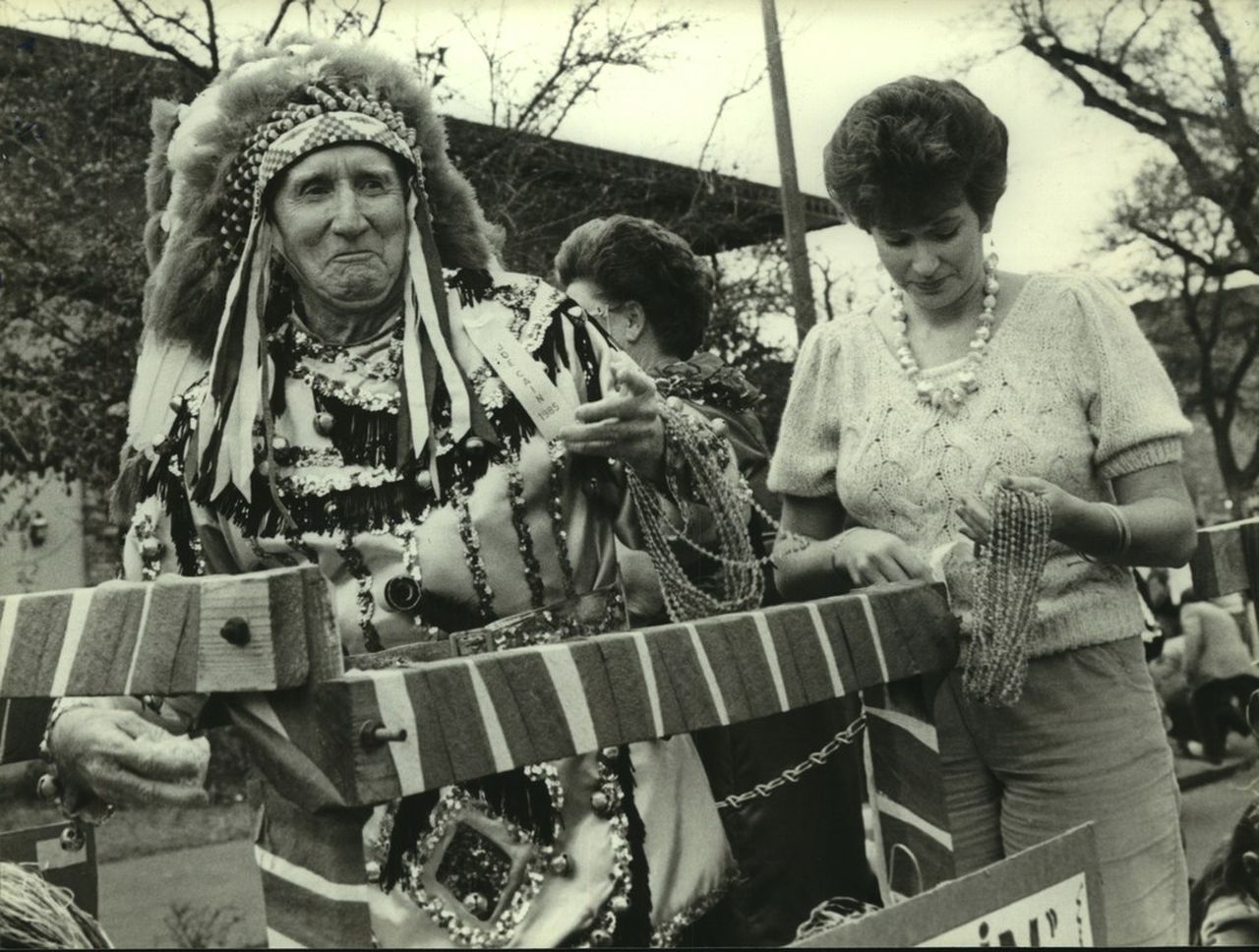
James “Red” Foster dressed as Chief Slacabamarinico in 1985. (archives)
A: If you go back in time and match it with other events, it was a product of the 60s. But it was also a product that almost died. Judy (Rayford) envisioned it strictly as totally a foot procession. The first year there was probably 40-60 people, if that many, in the procession in which they reburied (Cain) the first time. The second year, there were very few in the procession. It just wasn’t gaining momentum. I was working in marketing with the state at the time, and that was back in the day in which the newspapers having almost anything of interest (within them) and had a section of interest that covered (Mardi Gras) and it seemed like 25,000 radio stations. They were always looking for stuff. We started basically a campaign. Red (Foster) would go the TV stations and dance. I would do talks. We’d go to 4th grade classes, and he would talk a little bit and dance and carry on. We’d got to the state Capitol in Montgomery and (Foster) would dance around Lurleen Wallace’s statue and throw beads and everyone would come out of their offices. We’d do proclamations that the Mobile Press-Register would cover with Red sitting in the chair of the governor. It started exploding to the point where it got out of control.
Red was the type of guy who had no problem in going into the crowd and talking to anyone. Judy had no problem doing that. That’s one key character of the chief. He’s a character for all the people.
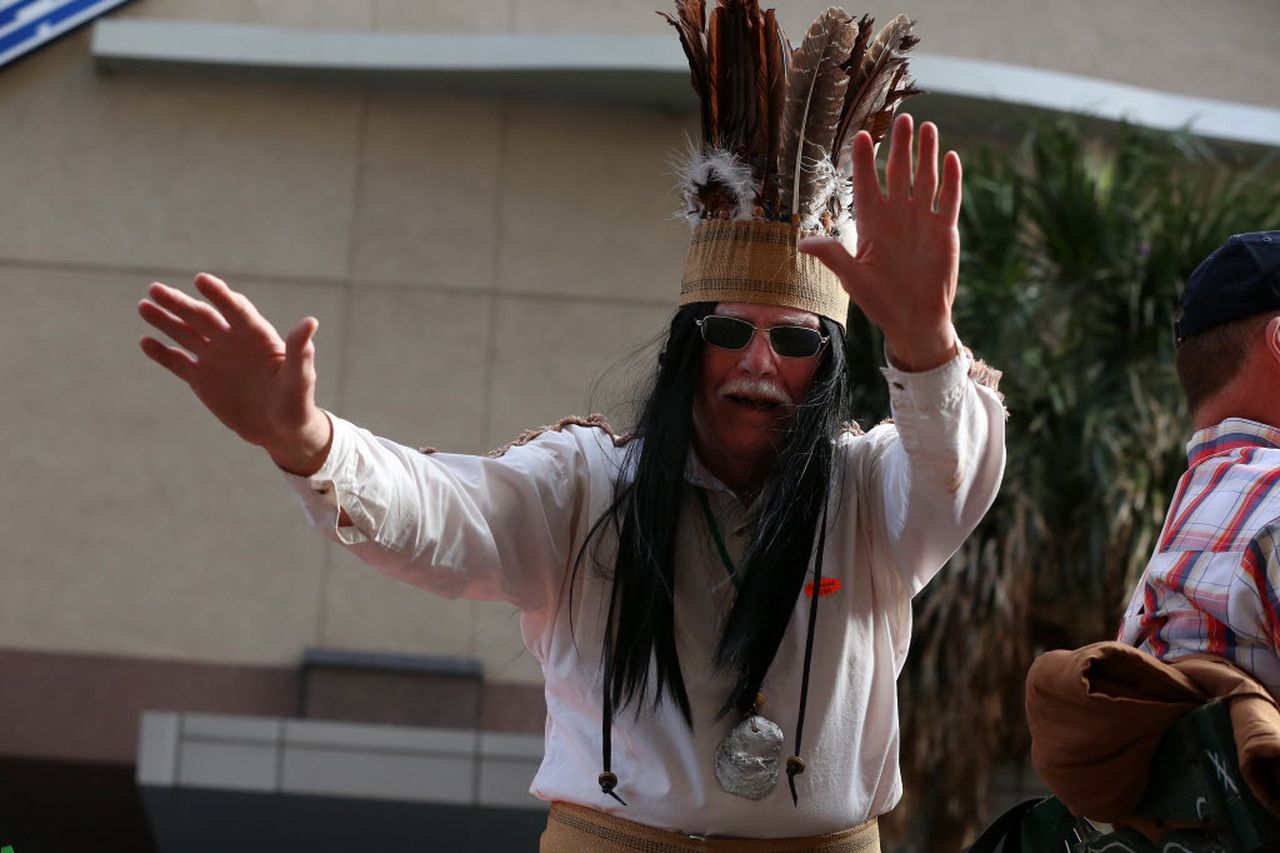
Wayne Dean Sr., dressed as Cain’s Indian chief character, Slacabamarinico, leads the foot marchers in the annual Joe Cain Day Procession in downtown Mobile, Ala., on Sunday Feb. 15, 2015. (file photo)
Q: Joe Cain Day is different than all of the Mardi Gras days largely because of why?
A: It’s because of its origin as a holiday for all of the people and the People’s Parade. Even today, the marching part, you can still come down and take part without paying a dime. You just have to dress up, or not dress up, and join the procession. That spirit has made it the People’s Parade even though the units now are just like another parade behind the procession. But still, the units are different groups of people. It’s not one organization. You have to coordinate it. But it’s the spirit of, ‘we can come down and have a grand day today and it’s the people’s day.’ Joe Cain Day is the people’s day.

One of Cain’s Merry Widows kneeling beside his tombstone at the Church Street Graveyard in Mobile, Alabama, during the Joe Cain Day celebration in 1976. The organization formed in 1974 and is considered the most secretive groups in Mobile Mardi Gras. (file photo).
Q: Explain the Merry Widows appeal to the celebration?
A: The Merry Widows are very unique in Mobile Mardi Gras. There was a widow in the first procession, in ‘67. Jimmie McWhorter, she worked in the library. When Judy put together the procession during the funeral as they reburied him, (McWhorter) said ‘he really needs a Widow.’ It was kind of like, ‘OK, we did that and it’s over.’ A few years later in 1974, they got together and decided for whatever reason to get together and become Joe Cain’s Merry Widows. They are probably the most limited and by far the most secretive society of Mobile. There are only 20 of the girls. Even when being interviewed by TV or radio, they never go by their real names. Their veils always mask their identity. They have a Southern name they go by. They all claim to have loved Joe best.
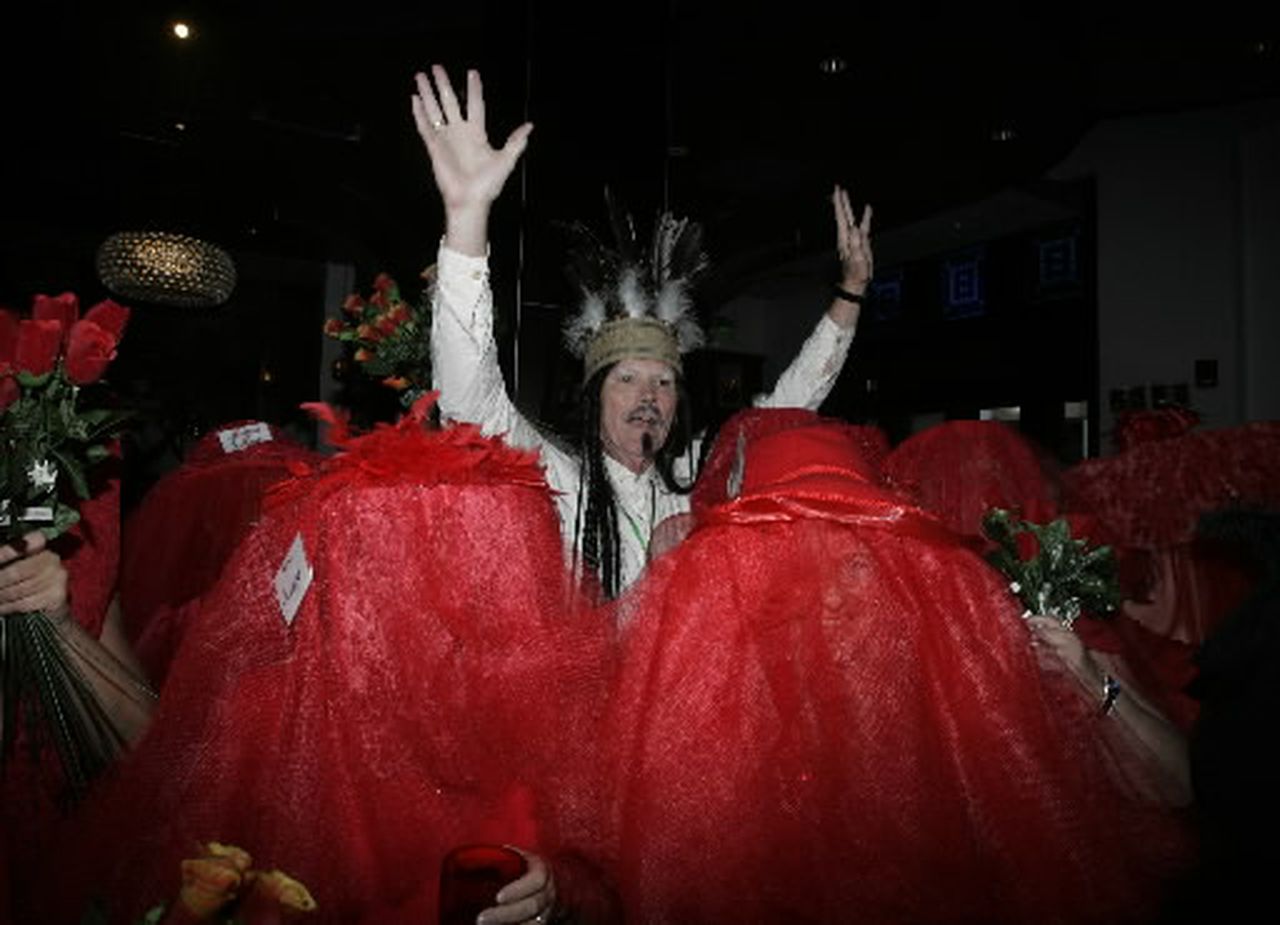
The Rev. Wayne Dean, portraying Joe Cain in his role as Chief Slacabamarinico dances with the Joe Cain mistresses during the grand opening of the Joe Cain Cafe celebration on Tuesday, June 3, 2008, at the Battle House Hotel in downtown Mobile, Ala. (file photo).
The fun part of the Widows is there are 20 of them on Joe Cain Day, but Joe Cain only had one wife. He was married to the love of his life, Elizabeth Rabby, until they both died. You do crazy things like this.
Then along a few years later come along the Mistresses, who Joe Cain couldn’t take about. But they were the ones who Joe Cain really loved best but couldn’t talk about.
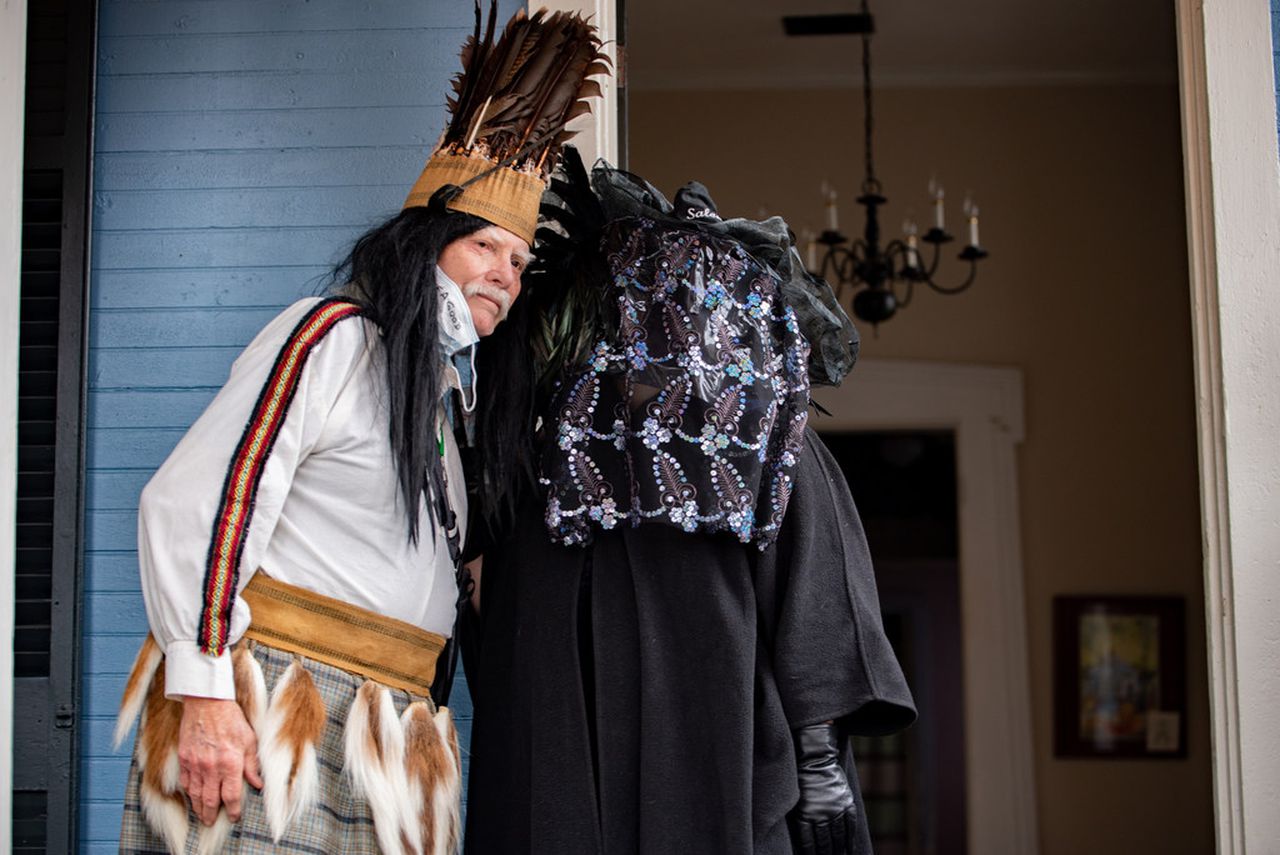
Wayne Dean, who portrays the Mardi Gras character Chief Slacabamarinoco, is seen with Merry Widow Salome at Joe Cain’s house in downtown Mobile on Joe Cain Day, Feb. 14, 2021. (file photo)
Q: Who is Slac IV’s favorite widow?
A: Whichever one is hugging me at the time is my favorite.
Q: Joe Cain would probably have heartburn over all of this to-do?
A: Yes, he would. That’s another good question: What would think of your name spread all over the place? Or your picture being posted all over Mobile? The other thing I’ve often pondered, and knowing Julian Rayford, there two things he wanted to accomplish for Joe Cain. He wanted to give him the fame he though he deserved for reviving Mardi Gras. I think that has been accomplished. The name is a household name. The other thing is he wanted to create something that was for everyone to get involved. I don’t know how he would think about how it has evolved today, but we surely have a lot of people out there.
